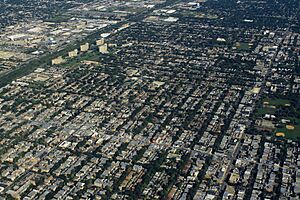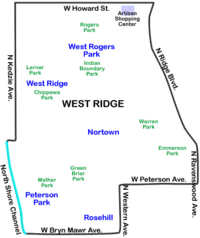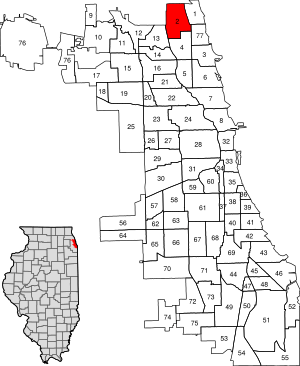West Ridge, Chicago facts for kids
Quick facts for kids
West Ridge
|
|
|---|---|
| Community Area 02 - West Ridge | |

Location within the city of Chicago
|
|

Streetmap
|
|

Location within the city of Chicago
|
|
| Country | United States |
| State | Illinois |
| County | Cook |
| City | Chicago |
| Neighborhoods | |
| Area | |
| • Total | 3.53 sq mi (9.1 km2) |
| Population
(2020)
|
|
| • Total | 77,122 |
| • Density | 21,848/sq mi (8,435/km2) |
| Demographics 2019 | |
| • White | 40.60% |
| • Black | 11.6% |
| • Hispanic | 18.9% |
| • Asian | 23.8% |
| • Other | 5.2% |
| Educational Attainment 2019 | |
| • High School Diploma or Higher | 80.7% |
| • Bachelor's Degree or Higher | 38.4% |
| Time zone | UTC-6 (CST) |
| • Summer (DST) | UTC-5 (CDT) |
| ZIP Codes |
60645 and parts of 60659
|
| Median Household income 2019 | $53,877 |
| Source: U.S. Census, Record Information Services | |
West Ridge is one of the 77 official community areas in Chicago. It's a neighborhood located on the far North Side of the city. West Ridge is known as a middle-class area. It is part of the 50th and 40th wards of Chicago.
Today, West Ridge is one of Chicago's more successful communities. It has a rich mix of cultures, especially along Devon Avenue. You can also find historic mansions on Ridge and Lunt Avenues. Important places like St. Scholastica Academy are here. The neighborhood also has one of the highest average incomes on Chicago's North Side.
West Ridge is home to many different groups of people. It has the largest Hasidic Jewish community in the Midwest. Other groups include Irish American, German-American, Indian, Pakistani, Bangladeshi, Assyrian, Russian, Korean, and Rohingya immigrant communities.
Contents
History of West Ridge
West Ridge was once called "North Town." People often referred to it as "West Rogers Park." Its borders are Howard Street to the north and Bryn Mawr Avenue and Peterson Avenue to the south. To the east, it's bordered by Ridge Boulevard, Western Avenue, and Ravenswood Avenue. To the west, you'll find Kedzie Avenue and the North Shore channel of the Chicago River.
Long ago, West Ridge was connected to its neighbor, Rogers Park. However, in 1890, it decided to become its own village. This happened because of a disagreement about park districts, which was even called the "Cabbage War"! West Ridge officially became part of Chicago on April 4, 1893, at the same time as Rogers Park.
Exploring West Ridge's Geography
Neighborhoods and Special Areas
The Golden Ghetto Area
The area known as the Golden Ghetto is located between Warren Park and Pratt Avenue to the north and Peterson Avenue to the south. It got its name because a large and active Jewish community lived there from about 1930 to the mid-1970s. At its peak in the 1960s, over 47,000 Jewish people lived in this neighborhood.
Starting in the 1960s, many Jewish families began moving to the suburbs. Around the same time, people from South Asia and Russian Jews started moving into the neighborhood. More recently, in the late 2010s, there has been a new increase in Jewish residents, especially Orthodox families. The number grew from 20,000 to about 25,000.
The famous book Crossing California by Adam Langer tells stories about this area during its busiest time. The book shares the experiences of kids growing up there in their middle school and teenage years.
Rogers Park Manor Bungalow Historic District
The Rogers Park Manor Bungalow Historic District is a special area in West Ridge. It's known for its historic homes. The district includes 329 buildings. A large number of these, 247, are "Chicago bungalows." These unique homes were built in the 1920s. This district was added to the National Register of Historic Places on November 15, 2005. This means it's recognized as an important historical place.
Talman West Ridge Bungalow Historic District
Another historic area in West Ridge is the Talman West Ridge Bungalow Historic District. This district has 272 buildings. Out of these, 181 are either brick Chicago bungalows or older stucco bungalows. These homes were built between 1919 and 1930.
West Ridge Population Facts
| Historical population | |||
|---|---|---|---|
| Census | Pop. | %± | |
| 1930 | 39,759 | — | |
| 1940 | 43,553 | 9.5% | |
| 1950 | 47,930 | 10.0% | |
| 1960 | 63,884 | 33.3% | |
| 1970 | 65,477 | 2.5% | |
| 1980 | 61,129 | −6.6% | |
| 1990 | 65,374 | 6.9% | |
| 2000 | 73,199 | 12.0% | |
| 2010 | 71,942 | −1.7% | |
| 2020 | 77,122 | 7.2% | |
| Sources: | |||
The population of West Ridge has changed over the years. The chart above shows how many people lived there during different census years. For example, in 1930, there were about 39,759 people. By 2020, the population grew to 77,122.
Schools in West Ridge
West Ridge has many schools for students of all ages.
Public Schools
Chicago Public Schools manages the public schools in the area.
- Clinton Elementary School
- Jamieson Elementary School
- Daniel Boone Elementary School
- Stephen Decatur Classical School
- George Armstrong Elementary School
- Philip Rogers Elementary School
- Stone Scholastic Academy
- West Ridge Elementary School
- Stephen Tyng Mather High School
Private Schools
There are also private schools available:
- Victor C. Neumann School
- Tzemach Tzedek Elementary School
Getting Around West Ridge
Public transportation helps people move around West Ridge. Bus services are provided by the Chicago Transit Authority (CTA) and Pace. If you need to travel by train, the Metra rail system is available at the Peterson/Ridge station.
Famous People from West Ridge
Many interesting people have connections to West Ridge:
- Sidney Blumenthal (born 1948) is a journalist and political advisor. He worked for President Bill Clinton. Sidney lived on West Birchwood Avenue in West Rogers Park when he was a child.
- Howard W. Carroll (1942–2021) was a member of the Illinois Senate for many years. He lived on North Francisco Avenue during his time in politics.
- Philip H. Corboy (1924–2012) was a well-known trial lawyer. He grew up in West Rogers Park, living on West Lunt Street.
- Leo Lerner (1907–1965) was a newspaper publisher. Records show he lived on West Lunt Avenue in 1940.
- Louis A. Lerner (1935–1984) was a United States Ambassador to Norway. He also lived on West Lunt Avenue in 1940.
- John H. Leims (1921–1985) was a Captain in the United States Marine Corps. He received the Medal of Honor, a very high award for bravery. He lived on North Talman Avenue in West Ridge.
- Louis Trinca-Pasat is an American football player who was raised in West Rogers Park.

